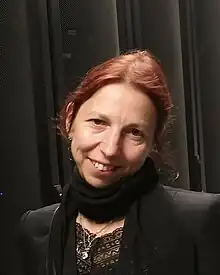Sarah Harris (scientist)
Sarah Anne Harris is a British physicist who is an Associate Professor of Biological Physics at the University of Leeds.[1][2] Her research investigates biomolecular simulations and the topology of DNA. In particular, she makes use of molecular dynamics to explore how DNA responds to stress. She serves as chair of the Engineering and Physical Sciences Research Council (EPSRC) computational collaborative project in Biomolecular simulation.
Sarah Harris | |
|---|---|
 | |
| Born | Sarah Anne Harris |
| Alma mater | University of Oxford (BA) University of Nottingham (PhD) |
| Awards | Suffrage Science award (2019) |
| Scientific career | |
| Fields | Biological physics Molecular simulation[1] |
| Institutions | University College London University of Leeds |
| Thesis | Theoretical investigations of DNA structure and dynamics (2001) |
| Website | astbury |
Early life and education
Harris was an undergraduate student in physics at the University of Oxford.[3] She was a graduate student at the University of Nottingham where she studied the structure and dynamics of DNA.[4]
Research and career
Harris joined University College London where she worked on condensed matter physics.[5] She joined the faculty at the University of Leeds in 2004, where she holds a joint position at the Astbury Centre for Structural and Molecular Biology.[6] Her research considers the development of theoretical and computational biophysical tools to address open questions in molecular biophysics.[6] Circular DNA sequences are present in bacterial, mitochondrial and cancer genomes, and offer promise for the design of gene vectors.[6] These circular sequences can withstand superhelical stresses, resulting in the formation of DNA supercoils. Whilst such supercoils are frequently observed in vivo, their closed topology renders them more challenging to study experimentally than their linear counterparts.[6] To this end, minicircles of DNA (closed double-stranded DNA sequences) have been proposed as model systems. Harris developed the mathematical models and atomistic molecular dynamics simulations that can accurately describe these DNA supercoils.[7] Harris was involved with the development of Fluctuating Finite Element Analysis, a mesoscale modelling tool that makes use of contiuum mechanics used to predict bimolecular dynamics in globular macromolecules and proteins.[8] FFEA makes use of 3D volumetric information, such as Cryo Electron Tomography maps.[6]
In 2020, Harris was appointed Chair of the Engineering and Physical Sciences Research Council (EPSRC) computational collaborative project in Biomolecular simulation.[9] The project unites biochemists, biophysicists and computer scientists in an effort to better understand biomolecular processes.[9] These include simulations that can describe the role of enzymes in biological reactions, the configuration of proteins in cell membranes and the design of effective pharmaceutical.[9] She serves on the management committee of High-End Computing Resources by the Biomolecular Simulation Community (HECBioSim), which provides access to High performance computing capabilities to scientists working on biomedical challenges.[10]
Alongside the scientific insights that can be gained from biophysical simulations, Harris is interested in the artistic outputs of theoretical biology. She published a collection of images that were generated during theoretical biology.[3]
Selected publications
Awards and honours
She won the Suffrage Science award in 2019.[14]
References
- Sarah Harris publications indexed by Google Scholar
- Sarah Harris publications from Europe PubMed Central
- The art of theoretical biology. Franziska Matthäus, Sebastian Matthäus, Sarah Harris, Thomas Hillen. Cham: Springer. 2020. ISBN 978-3-030-33471-0. OCLC 1152056183.
{{cite book}}: CS1 maint: others (link) - Harris, Sarah Anne (2001). Theoretical investigations of DNA structure and dynamics (PhD thesis). OCLC 53587989. EThOS 368362.
- Harris, Sarah Anne (1 January 2004). "The physics of DNA stretching". Contemporary Physics. 45 (1): 11–30. Bibcode:2004ConPh..45...11H. doi:10.1080/00107510310001624478. ISSN 0010-7514. S2CID 121070947.
- "Dr Sarah Harris". The Astbury Centre for Structural Molecular Biology. Retrieved 20 November 2021.
- Sutthibutpong, T.; Noy, A.; Harris, S. (2016). Atomistic Molecular Dynamics Simulations of DNA Minicircle Topoisomers: A Practical Guide to Setup, Performance, and Analysis | Springer Nature Experiments. Methods in Molecular Biology. Vol. 1431. pp. 195–219. doi:10.1007/978-1-4939-3631-1_15. PMID 27283311. Retrieved 20 November 2021.
- Solernou, Albert; Hanson, Benjamin S.; Richardson, Robin A.; Welch, Robert; Read, Daniel J.; Harlen, Oliver G.; Harris, Sarah A. (23 March 2018). "Fluctuating Finite Element Analysis (FFEA): A continuum mechanics software tool for mesoscale simulation of biomolecules". PLOS Computational Biology. 14 (3): e1005897. Bibcode:2018PLSCB..14E5897S. doi:10.1371/journal.pcbi.1005897. ISSN 1553-7358. PMC 5891030. PMID 29570700.
- "Management Structure". ccpbiosim.ac.uk. Retrieved 20 November 2021.
- "Home". hecbiosim.ac.uk. Retrieved 20 November 2021.
- Ivan Ivani; Pablo D Dans; Agnes Noy; et al. (16 November 2015). "Parmbsc1: a refined force field for DNA simulations". Nature Methods. 13 (1): 55–58. doi:10.1038/NMETH.3658. ISSN 1548-7091. PMC 4700514. PMID 26569599. Wikidata Q36428161.
- Harris SA; Gavathiotis E; Searle MS; Orozco M; Laughton CA (1 December 2001). "Cooperativity in drug-DNA recognition: a molecular dynamics study". Journal of the American Chemical Society. 123 (50): 12658–12663. doi:10.1021/JA016233N. ISSN 0002-7863. PMID 11741431. Wikidata Q33183169.
- Rossitza N Irobalieva; Jonathan M Fogg; Daniel J Catanese; et al. (12 October 2015). "Structural diversity of supercoiled DNA". Nature Communications. 6: 8440. Bibcode:2015NatCo...6.8440I. doi:10.1038/NCOMMS9440. ISSN 2041-1723. PMC 4608029. PMID 26455586. Wikidata Q22122088. (erratum)
- "Leading women in 'Engineering and Physical Sciences' receive awards on scheme's tenth anniversary". 8 March 2021.